When
considering what might cause us grief in 2012, few if any researchers
consider the start of the Mayan Long Count calendar to have any
importance. This is surprising, because the reason for the calendar
beginning on August 11 3114BC might contain clues about 2012 itself.
After all, the Mayan culture did not exist 5,000 years ago, so either
they randomly chose an ancient date on a whim, or an earlier
civilization was behind the calendar, and they knew something important
occurred on that date.
What could happen in 3114BC, and also in 2012AD? No
civilization has lasted that long, so they are unlikely to be man-made
events. Any natural events that occur so infrequently on Earth are
virtually impossible to predict (volcanic eruptions for example). So
that leaves us with astronomical events. The astrology of the pair of
dates has been well studied, so we can rule out alignments of the stars
and planets. That leaves the Sun, which we barely understand today, and
comets. Is there a comet with a periodicity of 5000 years, due to
return in 2012? Without any evidence from 3114BC it is impossible to
say. Given that we are now near the end of the Mayan 5th age, could
their calendar be designed to cover five orbits of a comet? And end
catastrophically in 2012?
Most people have not heard of Comet Caesar (it doesn't even
have a Wikipedia entry), and hopefully this will remain so. However, if
we are to suffer a terrible tragedy in 2012, it is currently my leading
candidate, and the purpose of this article is to explain why.
Comet Caesar was the most famous comet of its day, and
one of the brightest ever witnessed. It was visible during an annual
Roman festival held in 44BC, shortly after Julius Caesar's death. The
following quotes are from The Greatest Comets in History: Broom Stars and Celestial Scimitars by David Seargent:
This was the comet that blazed in the skies of Rome following the
assassination of Julius Caesar and which became immortalized by the
Romans on the reverse of a coin bearing a portrait of Augustus struck
in honor of the great Julius.
...According to Pliny, Octavian wrote that "On the very days
of my games, a comet was visible over the course of seven days, in the
northern region of the heavens. It rose at about the eleventh hour of
the day and was bright and plainly seen from all lands".
...In the fourth century of our era, Servius presented an
account that had the comet visible for 3 days and visible at midday and
during the daytime.
Comet Caesar is a parabolic comet - a comet
that returns less frequently than every 200 years. Most parabolic
comets have orbits significantly longer than 200 years, and very few
have ever been observed to make a complete orbit. Astronomers expect 50
percent of parabolic comets will receive gravitational nudges that
cause them to never orbit the Sun again. Those that remain in orbit
should be slowed with each passage, eventually becoming intermediate or
short-period comets. Therefore we either never see them again, or they
take so long to return that we don't know which, if any, have
historical records they match up with.
In my search for the most likely 2012 culprit, I have
constantly asked myself, could the ancients have predicted this?
Asteroids and comets are definitely predictable in a broad sense, and
all that it takes is observation and mathematics. Such calculations are
not easy. They require recalculating the orbit for every day of every
year, according to where the object is then located, and how the
planets are affecting its course. If ancient astronomers had considered
the period of a comet or asteroid to be fixed, rather than varying due
to the gravitational influences of planets, then there may have been
inaccuracies in any 2012 prediction they made. However the daily
recalculations were certainly not impossible in ancient times.
Predictability of Comets
Perhaps the most famous comet, even today, is Halley's Comet.
Edmond Halley - as well as a team of French mathematicians - predicted
the return of this comet, not just from knowing the dates of its past
visits, but by calculating the gravitational effects of planets like
Saturn and Jupiter. They did this by hand.
A single line in the Talmud suggests that 1st century Jewish astronomers were also aware of the periodicity of Halley's Comet:
To go from calculating the return of a comet, to having
"a star which appears once in seventy years that makes the captains of the ships err"
knowledge that it will probably strike Earth, is a major leap. Although
that is not to say they weren't merely predicting the return of a
spectacular comet, let's investigate the possibility that an ancient
culture was capable of predicting the actual impact of a comet in 2012.
First of all, for this hypothesis to have any validity, the
comet must be a long period one; that is, it must pass our planet less
frequently than once every 200 years. More frequent comets would be
well known by modern astronomers, and would most likely have their
future orbits determined.
According to Wikipedia, there are just 40 known comets with a periodicy
greater than 200 years (or non-periodic comets). Of these, 38 have been
observed since 1577AD. The only prior dates were 1106AD and 44BC. To me
this suggests that a great many earlier observations would have been
made, we just don't have evidence of such. The Great Comet of 1106AD
was seen from Europe to Japan. A Welsh text said of it:
Were we to have detailed records of comets from more
In that year there was seen a star wonderful to behold, throwing out behind it a beam of light of the thickness of a pillar in size and of exceeding brightness.
historical times, we might have a similar description with which we
could determine the periodicity of the 1106 comet. Without this, we
have nothing to base its return on - could be tomorrow, could be never.
You could say the same about Comet Caesar, the aforementioned
earliest recorded comet of 44BC. Without another record of it, we
cannot determine when it will return next. While there may not be any
surviving record of a prior passage, perhaps we can make an implication
from the Long Count calendar. If the end of the calendar is actually
the date a comet will strike Earth, what is the most logical reason for
the start date?
If, and this is obviously pure speculation, it had been
observed in 3114BC, and again in 44BC, could it be returning once again
in 2012? With a precise periodicity of 1025.2 years we get the
following sequence of dates:
- 3114BC - start of the Long Count calendar
- 2089BC - 2104/2105 is when the Great Flood occurred according to the Hebrew Calendar
- 1064BC - 1077 was the end of the Egyptian New Kingdom, marking the beginning of Egypt's decline
- 39BC - Comet Caesar was witnessed in 44BC
- 987AD - Dark Ages
- 2012AD - end of the Long Count calendar
Is 39BC close enough to 44BC? In 1758 the French astronomers who
calculated the return of Halley's Comet determined that the
gravitational effects of Saturn and Jupiter would make a difference of
618 days to its existing orbit, or almost 2 years. Is a difference of 5
years within 5 orbits outside the realms of possibility?
Variable Periodicity of Comets
When Comet Hyakutake was discovered in 1996, astronomers
determined that on the way in to our solar system it had an estimated
periodicy of 17,000 years, yet after having its orbit disturbed by the
largest planets, its new course meant it would take between 72,000 and
114,000 years to return.
When 23P/Brorsen-Metcalf was first discovered it was closest
to Earth in August 1847. After completing its orbit it was back in that
approximate spot in October 1919, and again in August 1989. The two
observed periods were 72 years and 70 years. That's roughly a 3%
deviation between 2 orbits.
The periodicy of a comet can vary from a little, to a lot, to
so much we never see it again. It is entirely possible that Comet
Caesar was seen the very same years as the Great Flood, the end of the
Eygptian New Kingdom, the start of the Long Count calender - and will
return in 2012.
Where are the records?
...they were either not observed or were observed andTo explain the absence of records for Comet Caesar prior
recovered by illiterate, uneducated peasants. It was quite unthinkable
that the sophisticated urban theologian of A.D. 1000... should take
seriously the allegations of such rabble that stones fell from the sky.
...Modern astronomers seeking accounts of ancient astronomical events ...find the records of medieval Europe sparse at best.
to 44BC is easy - lost in the annals of history that never made it. But
what of 987AD? Could it really go from observed in 44BC, to not
observed at all? Or has the record from 987AD +/-3 years, just
disappeared?
The former possibility is covered by the concept of dark
comets, described below. To answer the latter possibility, 987 was in
the Dark Ages, renowned for a lack of records. In fact so lacking that
some researchers have speculated that the era never existed at all!
Halley's Comet was observed in 837 according to records from
Japan, China, and Germany. The next observation was in 912, and was
recorded in the Annals of Ulster, like this: "A dark and rainy year. A
comet appeared". There is no specific record of its return in 990, and
was next spotted in 1066, where it was recorded as having an influence
on the Battle of Hastings.
The only mention of a comet circa 987AD (when I approximately
hypothesize Comet Caesar would have returned) is indirect, and
attributed to Eilmer of Malmesbury, a Benedictine monk:
You've come, have you? - You've come, you source of tears
to many mothers. It is long since I saw you; but as I see you now you
are much more terrible, for I see you brandishing the downfall of my country
He described this appearance in 1066. Because the previous passage of
Halley's Comet would have been in 990AD, and he was an "old man" in
1066, it is believed that he could have seen the comet when he was 5
years old, and have would been 76 years old in 1066 when he was quoted.
But what if he was just a few years older in 1066, and was actually
recalling a comet he witnessed in 987AD? Could he have seen the most
recent passing of Comet Caesar, and not Halley's Comet, in the closing
years of the tenth century?
Taking a different angle, if there is no specific record of
Halley's Comet in 990AD, it fits that a return of Comet Caesar circa
987AD also avoided any record that survives to this day.
For some, a simple lack of record will suffice, and the
hypothesis is feasible. For the others, I will describe a mechanism
from which the comet rapidly loses visibility.
Dark Comets
There's only one difference between dark comets and regular comets - we won't see the approach of the dark comet.
In early 2009 many news articles reported the findings ofNow Napier and Asher warn that some of these comets may
British astronomers Bill Napier (Cardiff University) and David Asher
(Armagh Observatory), and reading them sent a shiver down my spine,
prompting me to research the possibilities further.
"There is a case to be made that dark, dormant comets are a significant but largely unseen hazard," says Napier.
...periodic comet showers appear to correlate with the dates of
ancient impact craters found on Earth, which would suggest that most
impactors in the past were comets, not asteroids.
still be zipping around the solar system. Other observations support
their case. The rate that bright comets enter the solar system implies
there should be around 3000 of them buzzing around, and yet only 25 are
known.
Until now it was commonly accepted that more than 90% of
meteors and comets that could cause us harm were known and tracked by
astronomers and government agencies. That thousands of comets that are
potentially heading straight for us are not known or tracked is rather
frightening. How can a comet become dark?
The science is actually quite easy to understand. Comets
start out with ice on their surface. Every time they orbit around the
Sun, the heat melts some ice. Eventually there is no ice left. And the
only way we can easily see comets is from light reflecting off the ice.
In 1983, Comet IRAS-Araki-Alcock passed by Earth at aClark Chapman, from the Southwest Research Institute in
distance of 5 million kilometres, the closest known pass by any known
comet for 200 years. It was spotted only two weeks ahead of its closest
approach. "It had only 1 per cent of its surface active," says Napier.
Comet Borrelly, visited by NASA's Deep Space 1 probe in 2001, was found
to have extremely dark patches over much of its surface.
Boulder, Colorado, is not so concerned, saying that the dark comets
'would absorb sunlight very well' and therefore should be possible to
detect from the heat they would emit. I'm not qualified to judge this
statement, but from a layman's point of view, I would think a handheld
mirror reflecting the sun's light from a mile away is far more easily
seen than a slab of rock that is so hot you could fry an egg on it.
Here are a couple of examples of lost comets. One of the
reasons they are no longer observed could be that they have lost their
luminosity.
- 18D/Perrine-Mrkos - seen in 1896 and 1909, then 1955, then 1969, and not since.
- 5D/Brorsen - first spotted in 1846, last seen in 1879. With an
orbital period of 5.5 years. Has been as close as 0.52 AU to Earth, and
as far as 1.5AU. Japanese astronomers hoped to spot it in 1976, but
failed.
The orbital period of 5D/Brorsen suggests it could be passing by in
2012, if it is still on course. There is even a possible case of a dark
comet harming us (in a roundabout way) in recent times. Paul Wiegert of
the University of Western Ontario has determined that the dark comet
D/1895 Q1 (Swift) collided with NASA's Mariner 4 Mars probe in 1967.
Given that the comet was only ever observed in 1895/1896, there is not
enough data to be absolutely certain, but something took out the probe,
and a dark comet is the leading candidate.
Many lost comets could be coming close to Earth in 2012, but
without recent observations, there is no way of accurately calculating
their passage.
A long period comet would be the best candidate for a 2012 culprit for two reasons:
- an ancient civilization may have tracked comets for much longer
than our present civilization, giving them a great advantage in
determining the periodicy of long period comets - a longer period that adds up to a 2012 rendezvous is more
statistically reliable than that of a short period comet. Every passage
increases the chance of permutations due to encounters with the gravity
of planets it may pass. A comet that has orbited 4 times in the last
2000 years is more likely to still be on course that one that has
orbited unseen 50 times in the last 200 years.
Summary
Even without the possible return of Comet Caesar, dark comets are the
leading contender for triggering a predictable 2012 cataclysm. Comets
were known to the ancients - we have many ancient texts providing us
with descriptive names like "fire from the sky" - and their cyclical
nature makes it easy for any civilization with mathematical prowess to
predict. Thousands of hypothetical dark comets remain undiscovered in
modern times, and if we do find one on a collision course with our
planet, we may only have a few years, or even a few days, to prepare.
And those times will be times of mass panic.
Notes:
Steel, Rogue Asteroids and Doomsday Comets, 25. The
longest observed orbital period for a comet is 153P/Ikeya-Zhang with
341 years, having been discovered in 1661, and again in 2002.
Gribbin, Fire on Earth, 103
Of course there is the possibility that the Great Comet of
1106AD and the 44BC comet are one and the same. If that were true, it
could be expected to return circa 2250AD.
Lewis, Rain of Fire and Ice, 17
Parsons, Dark' comets may pose threat to Earth.
This has taken awhile to filter into the Western press, but an asteroid
exploded over the town of Bone, Indonesia on October 8th at around 11am
local time.
Initially, locals called the police to report that a plane had
crashed, or that an earthquake shook the ground, as reported in the Jakarta Globe. The Jakarta Post
quoted Thomas Djamaluddin, head of the Lapan Center for Climate and
Atmosphere Science Implementation as saying that the explosion was due
to a meteorite or bit of space junk that had entered the Earth's
atmosphere. As it turns out after further analysis, the explosion was
due to an asteroid about 5-10 meters (15-30 feet) in diameter exploding
in the air between 15 and 20 km (nine to 12 miles) above sea level.
Nobody was injured as a result of the explosion, but it evidently
caused quite a scare with the local population!
In a press release from the Near Earth Object (NEO)
program, the explosion was detected by many International Monitoring
System (IMS) infrasound stations, five of them 10,000 km (6200 miles)
away, and one 18,000 km (11,100 miles) from the blast. These stations
monitor seismic waves, infrasound (low frequency soundwaves),
hydroacoustic, and radionuclide emissions as part of the Comprehensive
Nuclear-Test-Ban Treaty Organization (CTBTO). They are well equipped to
monitor explosions of nuclear weapons, but also detect other events
such as meteorite impacts and asteroid explosions, tsunamis and
earthquakes.
When analyzed, the amount and intensity of low
frequency sound waves created by the explosion allowed researchers
Elizabeth Silber and Peter Brown of the Meteor Infrasound Group at the
Univ. of Western Ontario to determine that the explosion caused by the
asteroid was on the scale of 30 - 50 kilotons of TNT. To give you an
idea of how powerful of an explosion this is, the bombs dropped over
Hiroshima and Nagasaki in World War II exploded with the force of 20
kilotons of TNT.
A video of the explosion can be seen
The fireball - also called a bolide - created a dusty tail upon
entering the atmosphere of the Earth. It is estimated that the asteroid
was traveling around 72,000 km/hour (45,000 miles/hour) when it hit the
atmosphere. As an asteroid enters the thick Earth atmosphere, it slows
down abruptly and heats up due to the process of ablation. If this
asteroid were made of metal instead of rock, it would likely have
impacted the ground causing a lot of damage. Fortunately for the
residents of Bone and the surrounding area, the rock broke up in a
large fireball instead. There haven't been any reports of pieces that
have touched down as of yet.
Asteroids of this size are predicted to impact the Earth about
every 2-12 years, and the last one of this magnitude was a bolide over
the Marshall Islands on February 1, 1994. That impactor was estimated
to be between 4.4 and 13.5 meters. A full analysis of that event is
available on the SAO/NASA Astrophysics Data System.
Of course, events like this always raise the question of why the object
wasn't detected before it even entered the atmosphere. The NEO program
has cataloged over 600 objects in the size of 10 meters, but there are
many, many more out there. The cost of a monitoring and cataloging all
of the Near Earth Objects would be in the hundreds of millions of
dollars, but more events like this may spur the political will and
capital to further efforts at protecting human lives from the potential
damage of meteorite impacts.
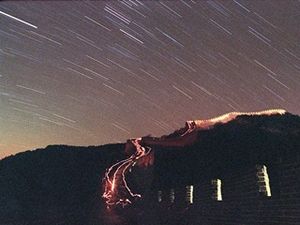
© Stephen Shaver/AFP/Getty Images
The
Leonid meteor shower lights up the sky above China's Great Wall as
stargazers brave the minus 20 degrees Celcius (minus 4 degrees
Fahrenheit) temperature and walk up the wall with their flashlights 18
November, 2008 in Badaling
The
Leonid meteor shower lights up the sky above China's Great Wall as
stargazers brave the minus 20 degrees Celcius (minus 4 degrees
Fahrenheit) temperature and walk up the wall with their flashlights 18
November, 2008 in Badaling
Authorities scrambled to
find a downed aircraft after numerous witnesses called to report seeing
a fireball plunge out of the sky, but the sightings may have been the
result of something a bit more astronomical.
Yolo County emergency crews searched the area near Interstate
5 and Interstate 505 just northwest of Zamora after multiple callers
reported seeing a ball of fire fall out of the sky, but found no sign
of any aircraft.
An emergency dispatcher with the Federal Aviation Administration confirmed that the event is part of the annual Leonid Meteor Shower, which lasts for a couple of weeks and isn't expected to peak until November 17.
Visible meteors typically appear as shooting stars to the naked eye,
but footage of other meteor sightings -- much of which is available on YouTube or other video sharing sites -- illustrate the spectacular potential of such events.
Authorities reported sightings all across Northern California, from the
central coast into the Amador County, relating to the meteor shower.
Sat, 07 Nov 2009 07:19 EST
American Museum of Natural History
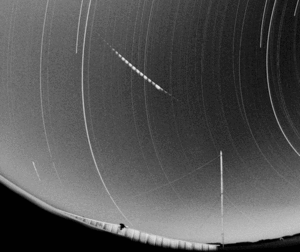
© Phil Bland, Imperial College
Time-lapse
image taken over one night of a fireball travelling across the sky. It
was taken from a fireball camera network or observatory in Western
Australia.
Time-lapse
image taken over one night of a fireball travelling across the sky. It
was taken from a fireball camera network or observatory in Western
Australia.
An unusual meteorite with an interesting
orbit has been tracked to the ground using a photographic observatory
that records time-lapse images of fireballs traveling across the sky.
The network of cameras is in the Nullabor Desert in Western
Australia. It allows scientists to track a fireball path, formed by a
meteorite as it travels through Earth's atmosphere, and then work out
where the meteorite comes to rest.
The fireball camera network project was set up by Dr Phil
Bland from Imperial College London and scientific associate of the
Natural History Museum, along with colleagues from Ondrejov Observatory
in the Czech Republic, and the Western Australia Museum, in 2006. This
is the first meteorite recovered using the network.
The cameras recorded the fireball that ultimately produced the
meteorite in 2007, and the fragments that fell to Earth were named
Bunburra Rockhole after a local landscape feature near to where they
landed.
The meteorite was found within 100m of the predicted
fall line. It was collected and samples were given to the Natural
History Museum where mineral experts Dr Gretchen Benedix and Dr Kieren
Howard helped examine and classify it. They produced data about the
meteorite's composition and the types of minerals within it.
Most meteorites found on Earth are believed to be fragments of
asteroids - ancient rocks that formed during the creation of the solar
system about 4.56 billion years ago.
Using complex calculations, the team were able to work out the
meteorite's path to Earth and its orbit, and from that, where in the
solar system the meteorite most likely came from.
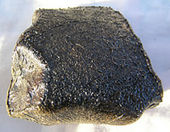
© Phil Bland, Imperial College
The Bunburra Rockhole meteorite is made from an usual type of basaltic igneous rock
The Bunburra Rockhole meteorite is made from an usual type of basaltic igneous rock
The
Bunburra meteorite is about the size of a cricket ball and is an
unusual type of basaltic igneous rock. Most basaltic meteorites are
thought to come from one asteroid. However, the composition of Bunburra
Rockhole means that it comes from a different asteroid.
This means that the process required to form this type of rock was happening in more than one place in the early solar system.
'It's vital to have a meteorite with information about where it comes from in the solar system,' says Dr Benedix.
'We've known for a long time that most meteorites are from the
asteroid belt, but we don't know exactly where. This kind of
information helps us fit one more piece in the puzzle of how the solar
system formed and evolved.
'The fact that this meteorite is compositionally unusual
increases it's value even more. It helps us to uncover more information
about the conditions of the early solar system.'
The team says that the meteorite had an unusual orbit. Using
modeling techniques, it was determined that Bunburra Rockhole began as
part of an asteroid in the innermost main asteroid belt between Mars
and Jupiter.
Its orbit gradually evolved into one very similar to Earth's.
Other meteorites for which data exist have orbits that take them into
the main asteroid belt.
Dr Howard says, 'I consider myself lucky to handle rocks from
space when usually I only know that they come from the curators'
cupboard!
'The chance to study a meteorite with a known orbit and source, so soon after if falls to Earth, is really exciting.'
Dr Bland concludes, 'It was amazing to find a meteorite that we
could track back to its origin in the asteroid belt on our first
expedition using our small trial network.
'We're cautiously optimistic that this find could be the first
of many and if that happens, each find may give us more clues about how
the solar system began.'
Several
people observed a massive meteor fireball emitting a brighter than
usual flash at around 8:30 pm on the 6th of November - it was observed
throughout the province. According to a statement from the Toyama
Observatory, it was a "massive fireball", a rare phenomenon caused by a
large mass of meteorite.
Watch the Sott web exclusive video below
The fireball was observed traveling in a northern direction. It lit up
the skies for a full two to three seconds, falling to an area unknown
at this time. The fireball divided into several individual pieces as
the meteor exploded in the middle with a white, yellow, and red
emission.
Usually when a meteorite enters the Earth's atmosphere, it
burns up due to a super-heated atmospheric friction. It is often known
as a "shooting star" -- But due to the size of this meteorite and its
strong longer glow, it caused panic among large populated areas around
the Tokyo vicinity.
People throughout British Columbia were treated to a spectacular light
show Saturday after what's believed to be a meteor lit up the sky.
Stephen Dalley and his wife were driving north of Comox, on Vancouver Island, at about 7 p.m. PT.
"We were shocked ... I mean, it wasn't what you'd expect, but it was bright white, with red and green and some blue colours, with a bit of a trail behind it and it was a large fireball," he said.
"[It was] approximately what the size of the moon would have been if we were looking at the moon."
Dalley said the intense light only lasted for about three seconds.
The streak of light was also seen about 500 kilometres northeast of Comox, near Vanderhoof.
In an email to CBC News, one witness in the area said, "a blue light flashed a moment before the meteor came down."
David Dodge, a retired astronomer who worked at the HR
MacMillan Space Centre in Vancouver, said it was likely a rock from
space.
He said this type of event is not unusual.
"These are happening all the time. We've had some very spectacular fireballs in the Malayasia area just a few weeks ago," he said.
"Earlier this year, there was a spectacular fireball that actually ended up in meteorites over Sudan, and a few weeks ago we had one over Vancouver, so these sorts of things are happening all the time."
Dodge said astronomers will use the sightings in the hopes of triangulating the spot where the rock may have landed.
A brilliant fireball was seen over California during the early evening
of November 7 at around 5:10 pm. Quite a few reports have been posted
in the comments sections on this blog.
A comment posting by Rich gives a rather detailed observation of the event:
"11/07/2009 at approximately 1700hrs we were driving south
form Santa Rosa on Hwy 12 and were passing through Sonoma when we
noticed a large brilliant white fireball in a SSW direction. It first
caught our attention at about 20 to 25deg off the horizon. Our visual
on it only lasted only about 3-4 seconds then just before passing the
hills in the distance it seemed to go out. There was no associated
noise or sign of impact. It was just gone. There was a smoke or debris
trail that we could see after the object was gone that was visible for
perhaps a minute or so then it was dispersed by the wind."
Pictures of the residual smoke trail can be seen on the Spaceweather.com site.
Additional news stories were published by the Daily Democrat, San Francisco Chronicle, Contra Costa Times, and others.
The fireball was most likely caused by a small asteroid,
probably no larger than a basketball. Though it is possible it may have
been related to the Taurid meteor shower which is near its maximum in
activity, it could easily be unrelated to any shower. The very bright
slow fireballs are usually asteroidal in origin while meteor showers
are usually produced by comets.
Comment: Another comment on that blog reads:
Reg - November 9, 2009
On November 7, 2009 around sunset, I was driving northbound on
US 101 15 miles south of Santa Maria, California. Fireball started
directly north at approximately 40 degrees above the north horizon,
headed vertically and burned-up (disappeared) approximately 3-5 degrees
above the north horizon. Head of fireball well formed burning sphere,
with long tail and sparks. At about 8 degrees above the horizon the
head split into two pieces.
I
was driving home from an Apple Festival this weekend when my 3 year old
daughter started shouting "Look Mama, a comet!!" I looked out the
window and to my amazement I saw I HUGE yellow and white ball of fire.
I immediately thought that I just witnessed a airplane explode in sky.
I called my husband freaking out and he said that it was probably a
meteor. I was driving on a highway and unable to pull over. I was able
to reach into my purse and get out my camera. By the time I was able to
get a photo through my front windshield (driving 55 miles/hr and one
handed LOL) the fireball had broken into 4-5 smaller pieces. I am still
not sure what exactly it was ... but it was really amazing and one of
the coolest things I've ever seen in the sky! I am so excited to share
my photo with you! Thanks for reading :)
A
previously undiscovered asteroid came within 14,000 km of Earth last
week, and astronomers noticed it only 15 hours before closest approach.
On Nov. 6 at around 16:30 EST a 7 meter asteroid, now called 2009 VA,
came only about 2 Earth radii from impacting our home planet. This is
the third-closest known non-impacting Earth approach on record for a
cataloged asteroid.
Early on Nov. 6 the asteroid was discovered by the Catalina
Sky Survey and was quickly identified by the Minor Planet Center in
Cambridge MA as an object that would soon pass very close to the Earth.
JPL's Near-Earth Object Program Office also computed an orbit solution
for this object, and determined that it was not headed for an impact.
The two closer approaches include the 1-meter sized
asteroid 2008 TS26, which passed within 6,150 km of the Earth's surface
on October 9, 2008, and the 7-meter sized asteroid 2004 FU162 that
passed within 6,535 km on March 31, 2004. On average, objects the size of 2009 VA pass this close about twice per year and impact Earth about once every 5 years.
Only thirteen months ago, another asteroid, 2008 TC3 was discovered
under similar circumstances, but that one was found to be on a
trajectory headed for the Earth, with impact only about 11 hours away.
It impacted in a remote area of Africa; no one was injured and
fragments have since been recovered for study.
The collision of a large extraterrestrial object with Earth almost 2
billion years ago may have stirred the seas worldwide and delivered a
huge serving of oxygen to the deep ocean.
The Sudbury impact, named after the Canadian city located near
the center of what remains of the ancient crater, happened around 1.85
billion years ago (SN: 6/15/02, p. 378).
Despite erosion since then, the impact structure - at least 200
kilometers across - is recognized to be the second-largest on the face
of the planet, says William Cannon, a geologist with the U.S.
Geological Survey in Reston, Va., and coauthor on a paper in the
November Geology. The event fundamentally affected the concentrations
of dissolved oxygen in the deep sea - enough to almost instantly shut
down the accumulation of marine sediments known as banded iron
formations, report Cannon and coauthor John F. Slack, also of the USGS
in Reston.
Banded iron formations,
massive deposits rich in iron oxides, have accumulated at several
periods in Earth's long-distant geological past, mostly when
atmospheric concentrations of oxygen were low (SN: 6/20/09, p. 24).
One extended episode of banded iron formation (or BIF) buildup suddenly
- and without an obvious explanation - ended about 1.85 billion years
ago, says Cannon. Over a very short interval, he notes, "the
environment shifted from one happily making banded iron to one that
wasn't."
In northern Minnesota and other areas nearby, the formations
lie directly underneath a thick layer of material only recently
recognized as ejecta from the Sudbury impact. Mark Jirsa, a geologist
with the Minnesota Geological Survey in St. Paul, was a member of the
team that identified the ejecta layer. "We intuitively connected the
Sudbury impact with the shutdown of BIF accumulation," he says. "But
now [Cannon and Slack] have come up with a model for how that might
have happened."
About 1.85 billion years ago, Earth's now separate landmasses
were joined in a single supercontinent. That also means there was one
large ocean, says Cannon. Many scientists suggest that the object that
slammed into Earth then - probably an asteroid abut 10 kilometers
across - splashed down in that ocean, in waters about 1 kilometer deep
on the shallow shelf surrounding the supercontinent. Models hint that
the tsunami spawned by the event would have been 1 kilometer tall at
the impact site and remained at least 100 meters tall about 3,000
kilometers away, Cannon adds.
Those immense waves and large underwater landslides triggered
by the impact stirred the ocean, bringing oxygenated waters from the
surface down to the ocean floor, the researchers propose. Sediments
deposited on the seafloor before the impact, including BIFs, contained
little if any iron in its Fe(III) form but were high in Fe(II), a sign
that most parts of the ocean were oxygen-free. But marine sediments
deposited after the impact included substantial amounts of Fe(III) but
very little Fe(II) - and, therefore, sizable amounts of dissolved
oxygen. The team's analyses suggest that after the impact, dissolved
iron spewed into the deepest parts of the ocean by hydrothermal vents
would have reacted with oxygen within a day or so, thereby choking off
most of the supply of Fe(II) to shallower waters where BIFs typically
accumulated.
While Cannon and Slack's model explains how BIF accumulation
might have suddenly ceased 1.85 billion years ago, it doesn't prove
that's how it happened, Jirsa warns. Nevertheless, he notes,
"scientists are closer to an explanation than we previously were." The
geological record suggests that environmental changes were happening in
oceans worldwide even before the Sudbury impact, he adds, "and the role
that the impact played, if any, in shutting down BIF accumulation isn't
well understood."
A mysterious object that ejects dust like a comet but orbits like an
asteroid could be a new class of object in the solar system.
In
1996, astronomers identified an extraordinary object orbiting the Sun
between Mars and Jupiter in a region best known for its asteroids. And
yet this body, called 133P, defied description: it had the orbit of an
asteroid yet emitted dust like a comet.
Clearly, this was a rare object. After centuries of
observation, not a single other object in the asteroid belt had burped
gas and dust in the same way.
So how could this have got there? According to Henry Hsieh at
Queen's University, Belfast in Northern Ireland, there can be only two
explanations. The first is that 133P is a comet that has somehow
recently become trapped in an asteroid-like orbit. This would have
required a hugely unlikely combination of gravitational kicks from
other planets as the comet travelled into the solar system from the
Kuiper Belt or Oort cloud.
Hsieh says this is so fantastically unlikely that it is almost
certainly a one-off event. So there's almost no chance that we'd see
another comet-like object in this kind of orbit.
The second explanation is that 133P is an asteroid formed
partly of ice and that this is being released, perhaps by a collision
with another asteroid. If this were the case, there would almost
certainly be other asteroids with a similar makeup releasing dust.
These we ought to be able to see.
So Hsieh set out to find one, making some 657 observations of 599
asteroids in the asteroid belt. The big news is that he has found one
other object, called 176P/LINEAR, which is also emitting dust.
So it looks as if the mystery is solved. That more or less
rules out the possibility that 133P is a captured comet. Instead, 133P
and 176P are a new class of comet-like asteroids made up partly of ice,
which is ejected whenever these objects are struck in the occasional
unavoidable collision.
That's an interesting new addition to the asteroid menagerie.
The only question now is what to call these beasts that are half comet
and half asteroid. Comsteroids? Asteromets? Hsiehroids?
- -
Ref: arxiv.org/abs/0907.5505: The Hawaii Trails Project: Comet-Hunting in the Main Asteroid Belt:
The mysterious solar system object 133P/(7968) Elst-Pizarro
is dynamically asteroidal, yet displays recurrent comet-like dust
emission. Two scenarios were hypothesized to explain this unusual
behavior: (1) 133P is a classical comet from the outer solar system
that has evolved onto a main-belt orbit, or (2) 133P is a dynamically
ordinary main-belt asteroid on which subsurface ice has recently been
exposed. If (1) is correct, the expected rarity of a dynamical
transition onto an asteroidal orbit implies that 133P could be alone in
the main belt. In contrast, if (2) is correct, other icy main-belt
objects should exist and could also exhibit cometary activity.
Believing 133P to be a dynamically ordinary, yet icy main-belt
asteroid, I set out to test the primary prediction of the hypothesis:
that 133P-like objects should be common and could be found by an
appropriately designed observational survey. I conducted just such a
survey -- the Hawaii Trails Project -- of selected main-belt asteroids
in a search for objects displaying cometary activity. I made 657
observations of 599 asteroids, discovering one active object now known
as 176P/LINEAR, leading to the identification of the new cometary class
of main-belt comets. These results suggest that there could be ~100
currently active main-belt comets among low-inclination,
kilometer-scale outer belt asteroids. Physically and statistically,
main-belt comet activity is consistent with initiation by meter-sized
impactors. The estimated rate of impacts and sizes of resulting active
sites, however, imply that 133P-sized bodies should become
significantly devolatilized over Gyr timescales, suggesting that 133P,
and possibly the other MBCs as well, could be secondary, or even
multigenerational, fragments from recent breakup events.
[Paper: The Hawaii Trails Project: Comet-Hunting in the Main Asteroid Belt [PDF]]
Wed, 11 Nov 2009 00:59 EST
Daily Mail
You almost certainly missed it - and luckily it missed you - but an asteroid has come within 8,700 miles of hitting the Earth.
Astronomers spotted the object only 15 hours before its closest approach to our planet last Friday.
Its orbit brought it 30 times nearer than the Moon, which is 250,000 miles away.
Even had it been on collision course with us, the 23ft wide asteroid -
known as 2009 VA - is unlikely to have made much of an impact because
it would probably have all but burnt up in the atmosphere.
It was picked up by the Catalina Sky Survey at the University
of Arizona, then identified by the Minor Planet Centre in Cambridge,
Massachusetts as a near Earth object and plotted by experts at Nasa.
A father and son have an extraterrestrial explanation for the strange
rock that recently landed in their backyard in southwest Kansas. They
are convinced it's a meteorite.
Chandler Harp, 10, was playing in the backyard of his Liberal
home when he heard what sounded like an explosion about 15 feet from
where he was standing. He looked over to see a plume of dirt and debris
shoot 5 feet high.
At the bottom of a foot-deep hole, he found a 2-inch rock and showed it to his dad, Lee.
Once Lee Harp got a look at the metallic rock, he was certain it wasn't
from this world. He said, "I knew he had a meteorite."
A large ball of fire streaking across the night time skies just after
midnight had many Utahn's wondering what they saw early Wednesday
morning.
Dozens of calls came streaming into the ABC 4 newsroom with
people wondering if they saw a shooting star, others wondered if it was
the end of the world, military testing, or even a UFO.
People from Mona to Spanish Fork from Ogden to Bountiful all calling in
a very similar sighting. To many, it looked like a large fall of fire,
lightning up the sky, some say like daylight, others reported a blue
like light that lasted for about 30 seconds. And many reported hearing
a boom about 5 minutes later.
ABC 4 called Utah's NASA and Solar System Ambassador Patrick
Wiggins who says that it was a meteor also known as a bolide. From his
observatory near Stansbury Park he says the break up of the meteor
occured at about 240 to 250 degrees azimuth which puts it just north of
southwest. He also heard the sound of an explosion that would put the
breakup of the bolide about 100 km in that direction placing it high
above Granite Peak in the west desert.
We'd love to hear your stories of what you saw and what you heard from
where you live. Please put your comments on our website and we'll be
researching this today here at ABC4.
People from all over the Mountain West reported a "bright light" or "meteor streak" around midnight Wednesday morning.
Reports are coming in from Eastern and Southern Idaho, all throughout Utah and even Las Vegas.
Several viewers called into the Local News 8 newsroom reporting the bright light which lasted for just a few seconds.
Some have reported it as a "ball of light" and others called to say it looked more like a "green streak."
Media outlets in Salt Lake City report that some even felt a "slight rumble" or "sonic boom."
ABC sister station KTVX talked to NASA and Solar System Ambassador Patrick Wiggins.
Wiggins told KTVX that it was a meteor also known as a bolide. From his
observatory near Stansbury Park, Utah, he said the break up of the
meteor occurred at about 240 to 250 degrees azimuth which puts it just
north of southwest.
He also heard the sound of an explosion that would put the breakup of
the bolide about 100 km in that direction placing it high above Granite
Peak in the west desert of Utah.
- -
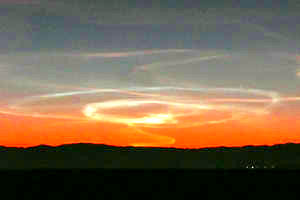
© SLTrib/ Les Ashwood
A
photo believed to be depicting the meteor's aftermath, taken at 7 a.m.
Wednesday, Nov. 18, 2009, from Clive, in western Tooele County, looking
east toward Salt Lake City.
A
photo believed to be depicting the meteor's aftermath, taken at 7 a.m.
Wednesday, Nov. 18, 2009, from Clive, in western Tooele County, looking
east toward Salt Lake City.
Watch Twitter video from Utah:
As forecasters predicted, there was a surge of Leonid meteors during
the late hours of Nov. 17th. Preliminary counts from the International
Meteor Organization exceed 120 meteors per hour.
A remarkable midnight fireball that "turned night into day" over parts of the western United States last night was not a Leonid.
Infrasound measurements suggest a sporadic asteroid not associated with
the Leonid debris stream. The space rock exploded in the atmosphere
with an energy equivalent to 0.5 - 1 kilotons of TNT.
Approximately 6 hours later, observers in Utah and Colorado witnessed a twisting iridescent-blue cloud in the dawn sky.
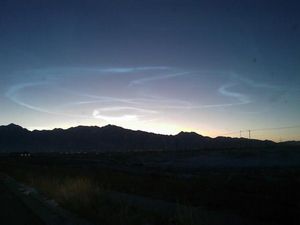
© Jeff Kendrick
Image taken: Nov. 18, 2009
Location: Looking South East of SLC, UT just before dawn 11/18/2009
Details: First appeared as a ring when the eastern sky was dark. Disappeared completely as the sun came up
Image taken: Nov. 18, 2009
Location: Looking South East of SLC, UT just before dawn 11/18/2009
Details: First appeared as a ring when the eastern sky was dark. Disappeared completely as the sun came up
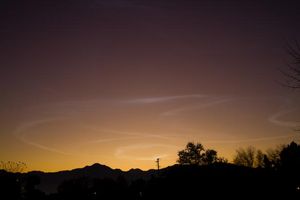
© scott stringham
Image taken: Nov. 18, 2009
Location: Salt Lake City, Utah
Details: going to work witnessed this cloud. it was BLUE!!!
Image taken: Nov. 18, 2009
Location: Salt Lake City, Utah
Details: going to work witnessed this cloud. it was BLUE!!!
Debris
from the fireball should have dissipated by that time, but the cloud
remains unexplained; we cannot yet rule out a connection to the
fireball event. Stay tuned for further analysis.
videos: #1, #2, #3.
A fast moving meteor lit up the night skies over most of Utah just
after midnight Wednesday. Moments later, the phones lit up at KSL as
people across the state called to tell us what they saw and ask what it
was.
Utahns are still talking Wednesday about what scientists are
calling a "remarkable midnight fireball." The source of all the
excitement was basically a rock, falling from space. When a meteor
enters the atmosphere, it gives off a lot of heat and light.
Folks at the Clark Planetarium say this rock was big--between the size of a microwave and washer-dryer unit.
At exactly 12:07, people from all over the western United States
watched as the bolide meteor crashed into Earth's atmosphere. In some areas, the flash of light was so bright it caused light sensor street lamps to shut off.
Clark Planetarium Director Seth Jarvis said the stony meteorite was
probably around the size of an oven, traveling 80,000 miles an hour
when it hit our atmosphere and went splat like a bug on a windshield.
He said it happened 100 miles up in the air, so despite the brightness,
Utah was never in any danger.
"These collisions can do damage, but they are extremely rare,
and literally once in a century do you observe something that's
actually doing damage," he said.
Witness Andy Bailey said, "Oh, it lit up the whole sky, like almost brighter than the day. It was bright."
Don White was in Wyoming and told KSL Newsradio for a moment he suspected a nuclear strike.
"With something that brilliant and that fast, it was like, whoa, did we
just get hit or something? It would have been some bigger noise I guess
if a nuclear device had gone off," he said.
"I've seen falling stars before, but nothing like that before," said witness James Albin.
We have reports that the light show was picked up as far away
as Tucson, Santa Fe, Butte and Frisco Peak near Milford in southwest
Utah.
The University of Utah has an observatory at 9,500 feet on Frisco Peak which captured images of the fireball itself.
Everyone who saw it has a once-in-a-lifetime story.
Resident Jon Olschewski said, "I noticed to the left something
streaking through the sky. It was this meteor that was exploding. It
was breaking off into at least five big chunks."
Many surveillance systems captured the spectacular blast of light.
"When
you got this mass coming through the atmosphere, and these things are
going fast, it's like if you could travel that fast on I-15, you could
get from Salt Lake to St. George in a matter of 5 seconds. So these
things are really going, hits the atmosphere and it makes so much
pressure on its leading edge that it just shatters itself," Jarvis
explained.
Roy Merrell also saw the light. He said, "There was this flash in the room, the room basically just lit up."
Others recorded a sequence of shadows as fantastic as any Hollywood studio could create.
Patrick Wiggins,NASA Solar System Ambassador to Utah, said, "To
realize it was up so high, people are thinking it's right close, but
the thing was up so high it was seen between L.A., Las Vegas and, of
course, all over Utah. I mean, this thing was way up there."
Scientists believe it was not part of the famous Leonid debris
stream, instead a sporadic asteroid, a midnight fireball, which
exploded in the atmosphere with an energy equivalent of up to one
kiloton of TNT.
"It was almost, I could say, like celestial," Olschewski said. "You
know what I mean. One of those kind of moments like 'oh my gosh,' like
'I'm not ready' kind of thing."
In Tooele County, residents reported that they felt that
moment when the meteor shattered. Wiggins said it took about 5 minutes
for the sonic boom, but said he's not surprised people felt it.
"Most meteors, you don't hear them, but this one was close
enough and big enough that yeah, you definitely heard the thing. It was
exciting," he said.
Wiggins said, from his calculations, the pieces of the meteor
likely fell over Dugway. He said it's possible meteorites could also be
found elsewhere. He said it can't hurt to look around your yard; if you
happen to find one it could be worth thousands of dollars.
KSL also received video clips of the meteor from Utah residents. Click on the video links to the right to watch the clips.
-----
Story compiled with information from Alex Cabrero, Shara Park, Mary Richards and Randall Jeppesen.
Clara Kilbourn
The Hutchinson News
Wed, 18 Nov 2009 23:20 EST
The 2-inch-diameter gun-metal black rock that 10-year-old Chandler Harp
found Saturday in his Liberal backyard traveled a long way to get
there.
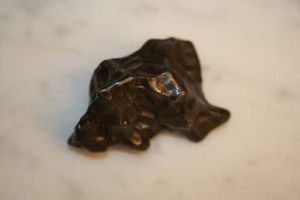
© The Hutchinson News/(Courtesy photo)
The triangle-shaped fresh iron meteorite discovered in Liberal fell to Earth from as far away as 100 million miles.
The triangle-shaped fresh iron meteorite discovered in Liberal fell to Earth from as far away as 100 million miles.
"There's no question in my mind whatsoever that
what they have is a meteorite," said Don Stimpson of Haviland, a
biophysicist who owns the Kansas Meteorite Museum and Nature Center on
U.S. 54/400 near Greensburg.
Stimpson made the trip from rural Kiowa County to
Liberal on Tuesday after he heard about the discovery of the meteorite
by Chandler, son of Lee and Teri Harp.
The iron meteorite tumbled to Earth from the center of the
atmosphere around the sun and fell from as far away as 100 million miles, Stimpson said.
"That's a part of the solar system that as humans we haven't investigated," he said.
It wasn't until after they launched an Internet search for meteorites
that Lee and Teri Harp thought seriously about the bull's-eye in their
backyard Saturday morning.
"It kind of scared us that they were in the backyard and a
projectile was coming our way," Lee Harp said about the triangular
object that could've hit their son or the family dog.
The meteorite was accompanied by what Chandler called a loud
explosion, "twice as loud as a TV," and dirt that flew five feet into
the air.
Stimpson, who has examined meteorites for the past 20 years,
called the rock "beautiful, well-formed as it burned through the
atmosphere."
Chandler's mother, a pharmacist, weighed it at 47 grams.
The dollar value of meteorites varies according to what
meteorite hounds are willing to pay, Stimpson said, but could reach
$100 per gram. At present there are about 1,500 meteorites posted for
sale on the Internet.
Stimpson added that it's been a good year for meteorites in Kansas. Three new meteorites have been confirmed, at Larned, Sawyer, and a third awaiting absolute confirmation and naming, near the Smoky Hill River.
Their son's find isn't for sale, the Harps said. For now the meteorite will remain in a display case in their home.
The discovery hasn't changed Chandler's mind about a potential career.
Instead of exploring outer space, the fifth-grader said he still wants to be an engineer and build things.
The Associated Press
Wed, 18 Nov 2009 15:25 CST
A basketball-sized chunk of ice crashed through the roof of a family's
Colorado home after apparently falling from an airplane passing
overhead. Danelle Hagan and her 9-year-old daughter were at home in
Brush on Saturday when they heard the kitchen ceiling come crashing
down. They were not injured.
"I hear a huge, what sounded like an explosion. And I look
over and my kitchen is basically in shambles," Hagan told KMGH-TV in
Denver. "It was very terrifying."
The Federal Aviation Administration was sending investigators
to the home to investigate whether the ice came from an airplane. The
Hagans put some of the ice in their freezer.
FAA spokesman Mike Fergus said Wednesday the ice chunk appears
to be "Rime ice," which can build up on the outside of a plane's
fuselage when it flies through cold and wet air.
Fergus says that it doesn't appear the ice was "blue ice," which comes from an airplane's toilet.
After investigators determine whether the ice came from a plane, Fergus
said they'll look at which planes are in the area at the time to see if
it's possible to tell which craft dropped the ice.
Fergus said that in cases of falling blue ice, FAA
investigators would inspect any plane that was in the area to make sure
it doesn't have a dangerous pressure leak. He said that ice falls from airplanes are alarming, but extremely rare.
He said the chances of getting hit by ice from a plane is "on the magnitude of a lightning strike."
Hagan's family is staying out of the house until it's repaired because
the crash loosened some asbestos. She says people were in the kitchen
just before the ice fell, so they're just glad to be OK.
"If we had been in that kitchen, it would have been devastating," Hagan said.
Comment: Extremely rare?
August 2007: Mysterious icy chunk smashes through roof in California
May 2007: Mysterious Chunk Of Ice Falls To Earth
January 2007: Car-destroying chunk may be icy meteor
January 2007: Ice Chunk Crashes Through Delaware Co. Home
April 2006: Ice crashes through college gym - No one is injured by the 2-foot chunk and no one knows yet where it came from
December 2005: Mysterious Ice Chunk Breaks Hole in Roof
December 2005: Ice chunk falls from sky in Japan
Karen Nelson
Sun Herald
Wed, 18 Nov 2009 15:09 CST
Keesler confirms jet training
Pascagoula - The boom that rattled windows in Pascagoula and Moss
Point, swamped police phone lines and brought entire neighborhoods of
people out of their homes to see what was happening was almost as much
a mystery Wednesday as it was Tuesday night when it happened.
Keesler Air Force base told city police around 8:45 p.m.
Tuesday the boom was caused by military jets on a training exercise in
the Gulf, but that the jets were not from Keesler.
On Wednesday security at the base reconfirmed the jets had
contacted the tower Tuesday night and were told there was a training
exercise.
But what jets, and whose jets were flying at supersonic speeds over the Gulf at night?
Keesler didn't know. Pensacola Naval Air Station's Air Operations on
the base said they weren't flying anything fast enough to cause a sonic
boom at present and suggested only the Air Force would have the F-15 or
fighter jets that could fit that bill.
They said Eglin AFB in Fort Walton Beach, Fla., was the best bet.
As it turns out, Eglin is the base that controls military
training ranges - airspace over the Gulf of Mexico used for military
maneuvers in this part of the Gulf.
Sgt. Brian Jones with Eglin's public relations office looked
at the schedule for Tuesday night and said, "In our air space at those
times all we had in the area were A-10s, and they're not fast enough to
break the sound barrier."
He said the A-10s were firing guns, but did not discharge any heavy explosives during the maneuver.
Jones said he had no way of knowing if there had been a jet outside Eglin's airspace.
There were four booms on Tuesday. One at 8 p.m. rattled the
east side of Jackson County all the way up to the rural northern
regions, according to reports.
Then there was a series of three booms about 9 p.m., felt and
heard in parts of Ocean Springs and Gautier to the west and in central
Jackson County, as well as Pascagoula and Moss Point in the east. Then
on Wednesday evening at about 8 p.m. at least one boom was felt in
Ocean Springs, Vancleave and Pascagoula.
Laurie Shields, who lives on Ocean Springs Road near Interstate 10 said
the 9 p.m. event on Tuesday shook her walls and made her roof rattle.
"You could hear the walls rattle it was so loud," she said.
A Moss Point resident said it moved pictures on her wall and
caused her dogs to bark; a student at Trent Lott Academy in Pascagoula
said his whole neighborhood came out of their houses and looked toward
the Chevron Refinery. Another said the boom set off a neighbor's home
security alarm.
And Capt. Shannon Broom with Pascagoula police said so many
calls came in to the department it overwhelmed the phone lines and
caused them to temporarily shut down.
Broom said Wednesday if training exercises were planned in the
Gulf with jets that might create sonic booms, he'd like to have been
warned ahead of time.
"They're the federal government, I guess they don't have to notify us, but it would have been nice," Broom said.
The U.S. is at war, so could there have been a super-secret maneuver?
Jones at Eglin said, "I'd tell you if there was something, and then I'd tell you we couldn't talk about it."
So that would be a "no."
The Air National Guard in Gulfport wasn't flying.
All the industry in Jackson County, including the refinery,
reported in to the state Department of Environmental Quality and the
city of Pascagoula that they were all clear, no incidents.
Pascagoula police checked with the U.S. Coast Guard.
Stennis Space Center in Hancock County said sometimes, with the
right atmospheric conditions, rocket testing can bounce off cloud cover
and travel a great distance.
But there was no rocket testing Tuesday night. That's scheduled for Friday.
NASA at the Houston Center, which also controls airspace over the western part of the Gulf, said it had nothing going on.
And the U.S. Geological Survey said although there had been 750
earthquakes in the United States in the past week, none was in or
around the Gulf.
Earthquake? Isn't that a little far-fetched?
Well, a spokesman for the National Earthquake Information Center in Denver said earthquakes can cause noise when they hit.
But after listening to a description of the noise as a boom, he
said the earthquake noise usually comes from the rattling rather than
before the shaking.
Rodney Chester
The Courier-Mail
Fri, 20 Nov 2009 09:10 CST
Experts say a fire ball that streaked across the sky above south-east
Queensland last night was a "chip off the old block of some asteroid".
The meteor was spotted by people from the Sunshine Coast, the Gold Coast and across Brisbane around 9.45pm.
Witnesses said the meteor was a green glow travelling from south-east to north-west, leaving a visible trail for 10 to 15 minutes.
Speaking on ABC radio this morning, Sir Thomas Brisbane Planetarium curator Mark Rigby ruled out space junk as an explanation.
"That's going the wrong way for space junk," he said. "Things are not launched in that direction."
Astronomers also dismissed the suggestion that the meteor was
part of the Leonid meteor shower that is associated with the comet
Tempel-Tuttle.
Every 33 years, the comet orbits the sun and leaves behind a dusty trail.
The meteor shower gets its name because the firey balls of dust
seem to be coming from the direction of the constellation of Leo in the
north-east.
While the Leonid meteor shower has created spectacular night
shows some years, the meteor seen over Brisbane last night was at the
wrong time and heading the in the wrong place.
The best place to see the Leonid meteor showers this year was in Russia, Kazak, China, Vietnam, Thailand, Nepal and India.
While the show usually lasts a few nights, the peak of the shower coincided with about 8am Brisbane time on Wednesday 18th.
Sapa
TimesLive.co.za
Sun, 22 Nov 2009 10:44 CST

© Lunar and Planetary Institute, Universities Space Research Association
Satellite
image of the Vredefort Dome meteor impact crater: South Africa is home
to the world's largest and oldest (known) meteor impact crater
Satellite
image of the Vredefort Dome meteor impact crater: South Africa is home
to the world's largest and oldest (known) meteor impact crater
"What people saw last night was almost certainly a meteor," Claire Flanagan an astronomer at the Johannesburg Planetarium said.
People saw a bright "greenish, bluish" light heading towards Pretoria at about 11pm on Saturday night.
"It moved over the Gauteng Province towards Limpopo... it travels very fast and was about 90 kilometres up," said Flanagan.
The meteor was a hot topic of discussion in the forum on mybroadband.co.za.
"I saw a light flash the sky at about 8pm, at first I thought I was
imagining it, but my friend also saw it," wrote someone who saw the
meteor.
"... Maybe it's people getting abducted by aliens...I walked
in the house looked out [and] the sky was lit. It looked how it
normally [does] at 5am."
Another wrote: "I [saw] it too in Hartbeespoort dam. Almost looked like daylight for a few seconds, not sure if it was a meteor or not... pretty cool..."
Others claimed to have heard and seen a "bright explosion".
"I was in Lonehill sitting outside with some friends at around 11pm
when my buddy noticed flashes in the distance. After he pointed, we looked up and that's when the sky lit up like day for a second or two. The sky actually went blue."
Flanagan said if a bang was heard, it meant that the meteor had disintegrated in the sky.
"The speed which it was travelling at would have caused it to burn and then disintegrate," she said.
Another user on the website said: "I think you guys should relax. It's
Wikus Van der Merwe and his prawns," in reference to the South
African-made movie 'District 9' which sets Johannesburg as the home of
alien creatures.
Flanagan said that if the meteor had landed it would not have caused a major impact.
She could say how big it was as it was unexpected, and not connected with any kind of shower, but said the planetarium would be investigating the incident.
Comment: Update: This is allegedly a video of "the meteor that passed through South Africa and landed in Botswana on Saturday":
Kevin Flynn
New York Daily News
Tue, 24 Nov 2009 14:36 CST

© Jet Propulsion Laboratory/AP
NASA is eyeing a manned mission to an asteroid, according to a report.
NASA is eyeing a manned mission to an asteroid, according to a report.
A TV space hit of the future could be 2020 Rock.
That's the rough target date NASA and space industry folks are eying
for a mission to send astronauts to a Near Earth Object, aka an
asteroid. Such a trip could be a stepping stone to Mars and extended
stays on the moon, and guide plans to head off dangerous space rocks on
a collision course with Earth, according to Space.com.
Lockheed Martin, builder of the next-generation Orion
spacecraft, the U.S. space program's successor to the shuttle, has
drawn up a "Plymouth Rock" plan for NASA touting the voyage as a way to
gain a foothold outside low-Earth orbit. Powerful telescopes and
beaming energy to Earth from space could be the eventual payoff.
The merits of a human mission to a Near Earth Object
were detailed last week during a Boulder, Colo., meeting of the Small
Bodies Assessment Group, established by NASA in 2008 to study
asteroids, comets, interplanetary dust, small satellites and far-flung
orbiters known as Trans-Neptunian Objects.
The plans are to be weighed by NASA and the White House, Paul
Abell, a research scientist at the Planetary Science Institute assigned
to the Johnson Space Center in Houston, told the Web site. "It's going
to take a bit of time. I don't think there's going to be a quick
decision."
How the White House will react to an asteroid trek is beyond
anybody's crystal ball, Space.com said, but the talk got the attention
of Lockheed Martin, which began its Plymouth Rock mission study a
couple years ago, said Lockheed's Josh Hopkins, in the company's
advanced programs for human space flight division in Denver.
Maximizing astronaut safety and coping with issues such as
trash management, cosmic rays and abort scenarios are still up in the
air, Hopkins noted. But given the core attributes already built into
the Orion system, he said, "we think it does make sense for the human
spaceflight program to be investigating this."
But there would be no landing on the asteroid. Instead,
astronauts would park nearby and jet-backpack to the surface. They'd
expect to haul back about 200 pounds worth of rock, gathering data
about the makeup of the objects that could be useful if one of them
were found hurtling toward the Earth someday.
"We assume staying at the asteroid for five days. They could
stay a week or two. But staying for a month gets hard," Hopkins said.
"We'd really like a larger pool of candidate targets so that
we could visit a NEO that has cool properties and would have the
greatest scientific return," Chapman told Space.com.
"Human exploration is for human purposes," said Mark Sykes,
chair of the Small Bodies Assessment Group and director of the
Planetary Science Institute in Tucson.
Science by itself doesn't drive human exploration, Sykes
noted, "but we can benefit, scientifically, from this. We'll take
advantage of whatever opportunities come our way!"
Sykes said the prospect that space rocks could hold resources,
such as a cache of water, or be useful in radiation shielding, may have
a profound impact on expanding sustainable human operations farther out
into space, Space.com reported.
If so, asteroids may well act as a linchpin for people living,
working and populating space, Sykes said. But are those resources
recoverable in an economic way?
"It's within the realm of consideration. Of course, a lot more homework needs to be done," Sykes stressed.
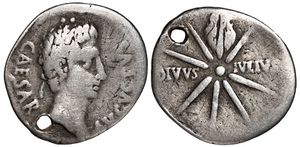
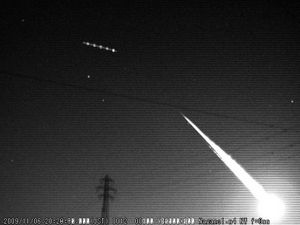
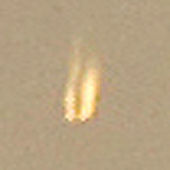
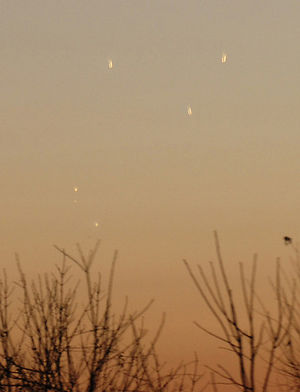
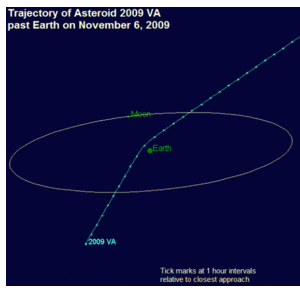
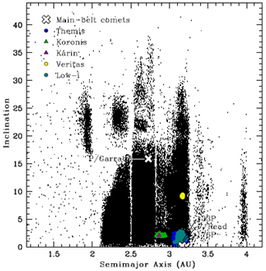
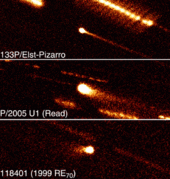

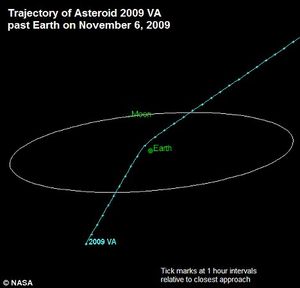

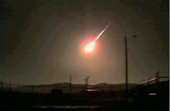
No comments:
Post a Comment